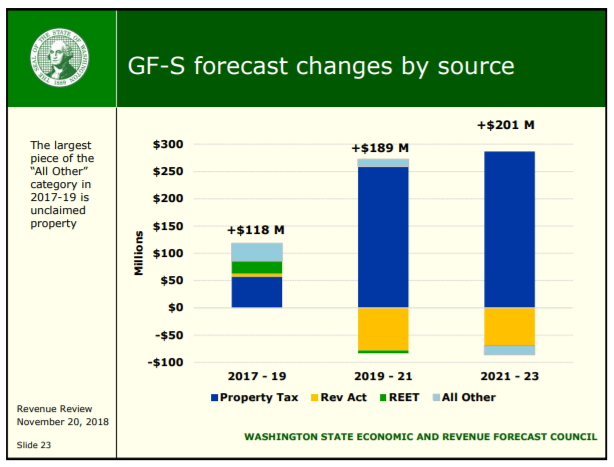3:59 pm
November 20, 2018
According to the Economic and Revenue Forecast Council (ERFC), state revenues are now expected to be up by $163.4 million in 2017–19, $195.5 million in 2019–21, and $209.2 million in 2021–23, compared to the September forecast. That means that revenues are estimated to be $45.799 billion in 2017–19, $50.002 billion in 2019–21, and $53.795 billion in 2021–23. (These figures are in terms of the near general–fund state plus opportunity pathways, or NGFS+.) Gov. Inslee will propose a 2019–21 budget based on these figures next month.
Notably, the property tax is driving the increases. The September forecast had assumed that 2019 assessed values would increase by 7.4 percent, but the ERFC now has access to the actual assessed value data, which show that values will increase by 10.9 percent. So the forecast of property tax receipts is increased by $57 million in 2017–19, $259 million in 2019–21, and $287 million in 2021–23.
Meanwhile, Revenue Act taxes (retail sales and use, business and occupation, public utility, and non-cigarette tobacco products taxes) are now estimated to be lower than in the September forecast.
Additionally, the ERFC adopted a new budget outlook. It is based on today’s revenue forecast, and it provides preliminary carryforward and maintenance level spending estimates for 2017–19, 2019–21, and 2021–23. It shows unrestricted NGFS+ ending balances of $1.633 billion in 2017–19, $689 million in 2019–21, and $221 million in 2021–23.
The methodology document defines the carryforward level as “a relatively mechanical calculation based on the removal of any one-time items and adjusting for the bow wave impact of items assumed in existing appropriations.” The largest carryforward item is $2.18 billion for K–12 salaries in 2019–21. Maintenance level is “the costs of continuing to comply with current law provisions” (including adjustments for caseload, utilization, and inflation).
The new ending balance estimates give legislators a bit more to work with than anticipated in April. But the outlook does not include the costs of the collective bargaining agreements negotiated for 2019–21, as they have not yet been determined financially feasible or approved by the Legislature. (A Senate Committee Services presentation to the Senate Ways & Means Committee earlier this month noted that the 2019–21 agreements would cost $1.9 billion over four years.) The outlook also doesn’t include the costs of the many new policy changes that will be proposed for the next biennium.
Categories: Budget , Categories.
